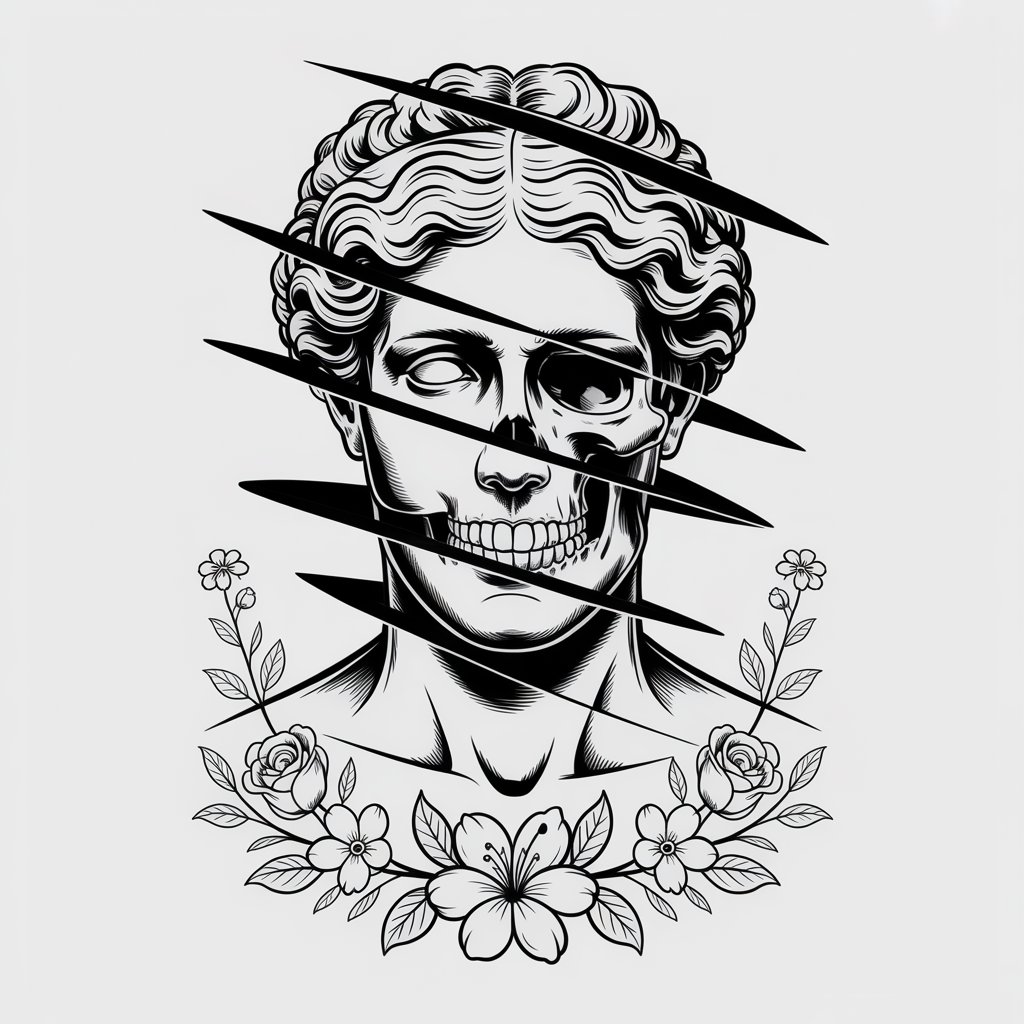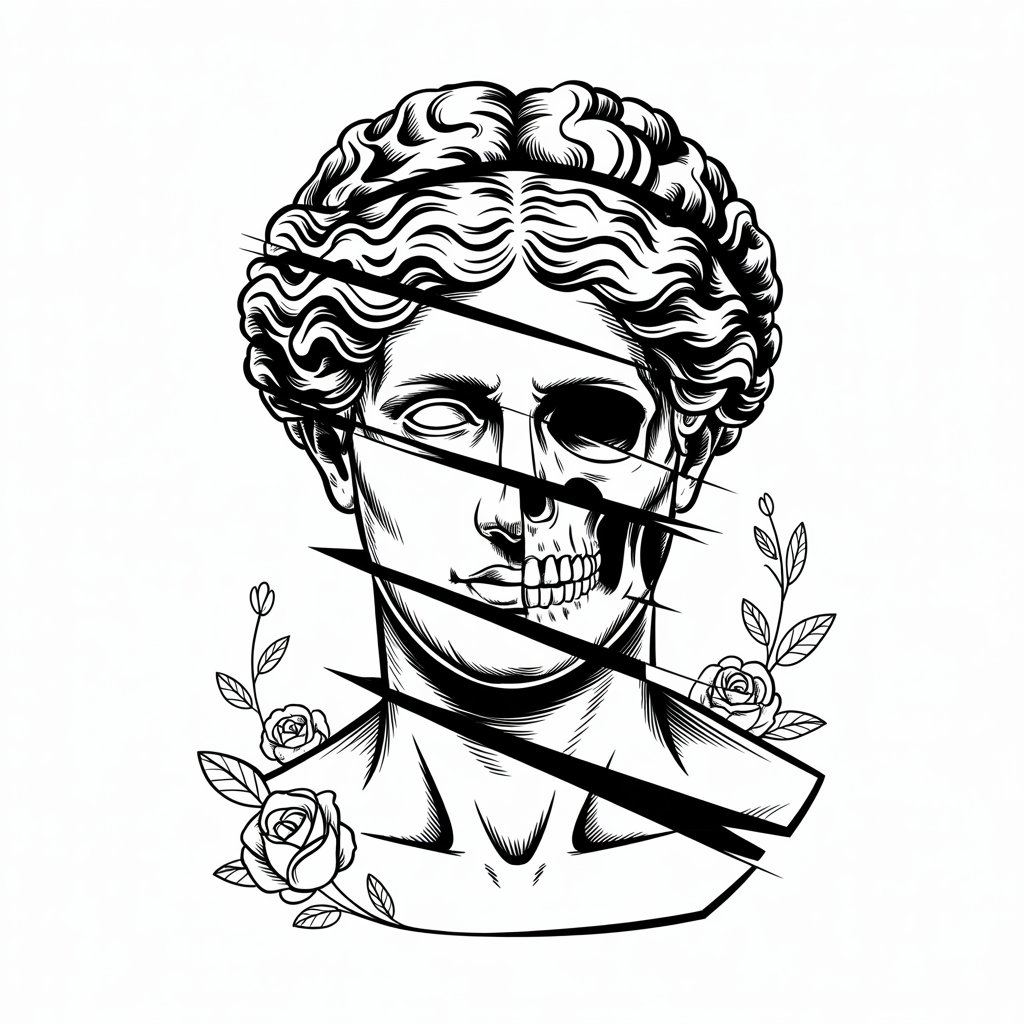The juxtaposition of classical sculpture with mortality imagery creates a striking aesthetic that has become increasingly popular in contemporary tattoo art. These designs, featuring Greco-Roman busts with portions revealing a skull underneath, speak to deep themes of beauty, impermanence, and the duality of human existence.
The Meaning Behind the Design
These tattoos draw heavily from the artistic concept of “memento mori” – Latin for “remember that you must die.” This centuries-old tradition reminds us of our mortality while celebrating life’s beauty. The classical sculpture represents idealized human form and achievement, while the skull represents our inevitable fate.
The sliced or fragmented style creates a dramatic visual effect, suggesting that beneath our surface appearance lies the same universal structure – we are all equal in death. The floral elements often included symbolize life’s beauty and brevity.
Ideal Placement Options
1. Upper Arm/Bicep
The curved surface of the upper arm provides an excellent canvas for these designs, allowing them to wrap slightly around the arm for a three-dimensional effect. This placement works particularly well for medium-sized pieces that can be revealed or concealed as desired.
2. Forearm
For those wanting to showcase their art more prominently, the foreform offers a flat, visible surface that displays the intricate line work beautifully. The classical bust design fits naturally with the arm’s shape, and the piece becomes a conversation starter.
3. Upper Back/Shoulder Blade
The broad, flat canvas of the upper back allows for larger, more detailed versions of these designs. Placing the classical bust on a shoulder blade creates a striking effect, especially when the design incorporates the natural contours of the body.
4. Chest/Pectoral
For a bold statement, the chest area provides ample space for a larger, more detailed design. The classical bust can be centered on the sternum or placed over one pectoral muscle. This placement carries significance as it positions the art close to the heart.
5. Thigh
The thigh offers one of the largest flat surfaces on the body, perfect for showcasing the intricate details of these designs. This placement allows for a substantial piece that can remain private or be displayed depending on clothing choices.
6. Side of Torso/Ribs
Though more painful for tattooing, the side of the torso creates a dramatic canvas for these designs. The vertical space complements the elongated nature of a bust sculpture, and the placement near the ribs creates a poetic connection to the skeletal imagery.
Pain Considerations
Different body areas vary significantly in tattooing pain levels:
- Low pain: Upper outer arm, thigh
- Moderate pain: Forearm, upper back, lower leg
- Higher pain: Chest, ribs, inner arm, neck
Size Recommendations
These designs work best when sized appropriately to showcase their intricate details:
- Small (2-4 inches): Can work for minimalist versions but may lose detail
- Medium (4-6 inches): Ideal for arm placements, preserves most details
- Large (6+ inches): Perfect for back, chest, or thigh placement, allows for maximum detail

Caring for Your Classical Skull Tattoo
To maintain the crisp black linework characteristic of these designs:
- Follow your artist’s aftercare instructions meticulously
- Apply sunscreen when the tattoo is exposed to prevent fading
- Moisturize regularly to preserve the skin’s elasticity
- Consider touch-ups every few years to maintain the sharp contrast
Finding the Right Artist
These detailed designs require specific expertise. Look for artists who:
- Specialize in blackwork and line art
- Have experience with anatomical drawings
- Can demonstrate clean, consistent line weight
- Have a portfolio showing similar neoclassical or illustrative designs
The striking contrast between classical beauty and mortality makes these tattoos both visually compelling and philosophically rich. Whether you choose a prominent placement or a more private location, these timeless designs serve as a daily reminder to appreciate life’s beauty while acknowledging its impermanence – the very essence of “memento mori.”


